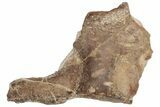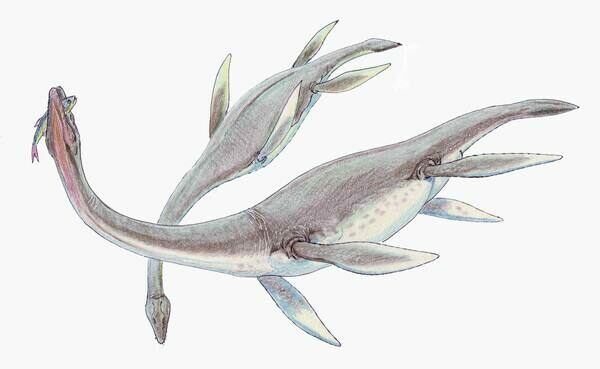This Specimen has been sold.
27.2" Fossil Plesiosaur Paddle & Coracoid - Asfla, Morocco
This is a well-preserved two piece fossil of a partial Plesiosaur paddle and coracoid bone that was collected from the Upper Cretaceous (Early Turonian Stage) deposits of Asfla, Morocco, north of Goulmima. There are three primary species of Plesiosaur described from this area; Thililua longicollis, Manemergus anguirostris and Libonectes atlasense. It is rather difficult to place this paddle in any of the three species, so we have decided to leave it unidentified. This specimen is quite interesting because it comes in two parts and allows for a glimpse into how the paddle moved. The paddle is absolutely massive and it only contains four of the average fifteen digits that comprise most paddles. The larger flat bone is the coracoid, the posterior section of the two plates that make up the plesiosaur's shoulder. It is the joint where the scapula and coracoid meet that the paddle articulated for propulsion.
Both fossils show signs of crack repair and gap fill restoration. This is to be expected because of the immensity of the bones. The pieces are professionally restored to ensure lasting integrity. It is an overall fun piece and would look good in any collection. Plesiosaur paddles, even semi-partials such as this, don't come along often and shouldn't be passed up.
This fossil is partially exposed from the rock it was found in and comes with a metal stand for each of the two parts.
Both fossils show signs of crack repair and gap fill restoration. This is to be expected because of the immensity of the bones. The pieces are professionally restored to ensure lasting integrity. It is an overall fun piece and would look good in any collection. Plesiosaur paddles, even semi-partials such as this, don't come along often and shouldn't be passed up.
This fossil is partially exposed from the rock it was found in and comes with a metal stand for each of the two parts.
Plesiosaurs were aquatic reptiles. They had small heads, long necks, broad, flattened bodies, short tails and large flippers or paddles. They are one of the best described groups of fossil animals with a total of 110 known species, many from complete or nearly complete fossils. The largest known is Elasmosaurus at 40 feet (12 meters), and the smallest was Thalassiodracon at just under 6 feet (1.5 meters). They first appear in the fossil record near the end of the Triassic Period, starting with Thalassiodracon from about 203 million years ago. They disappear from the fossil record about the time of the Cretaceous-Paleogene Extinction, along with the dinosaurs and most other reptiles.
Plesiosaurs were almost comical in their appearance: small heads full of sharp, cylindrical teeth; wide, comparatively flat bodies; short tails; and four large paddles or flippers. They are so odd-looking that when originally found, the first Plesiosaur fossil was mistaken for a new kid of Pterosaur. Even when the first Plesiosaur went on display, it had its head mounted on the wrong end! Plesiosaur necks could also have large numbers of vertebrae: Albertonectes had 72 in its neck!
Plesiosaurs swam by moving their paddles or flippers in much the same way that modern sea turtles do. This would have made them efficient and maneuverable, but not particularly speedy. Due to their long, thin necks and flippers, it is unlikely that Plesiosaurs left the water. If they did, they would not have been able to travel far. It had long been thought that Plesiosaurs left the water to lay eggs in much the same way as modern sea turtles. Recent evidence seems to prove they bore live young, making theories that they left the water less likely. It is widely held that plesiosaurs were not the fastest swimmers in the sea, cruising to catch their preys of various fish, squid, and other mollusks.
Plesiosaur fossils have been found worldwide. The first described fossil was found in Kansas. Since then, they have been found on every continent. Most commercially available Plesiosaur fossils come from Morocco and Kansas.
Plesiosaurs were almost comical in their appearance: small heads full of sharp, cylindrical teeth; wide, comparatively flat bodies; short tails; and four large paddles or flippers. They are so odd-looking that when originally found, the first Plesiosaur fossil was mistaken for a new kid of Pterosaur. Even when the first Plesiosaur went on display, it had its head mounted on the wrong end! Plesiosaur necks could also have large numbers of vertebrae: Albertonectes had 72 in its neck!
Plesiosaurs swam by moving their paddles or flippers in much the same way that modern sea turtles do. This would have made them efficient and maneuverable, but not particularly speedy. Due to their long, thin necks and flippers, it is unlikely that Plesiosaurs left the water. If they did, they would not have been able to travel far. It had long been thought that Plesiosaurs left the water to lay eggs in much the same way as modern sea turtles. Recent evidence seems to prove they bore live young, making theories that they left the water less likely. It is widely held that plesiosaurs were not the fastest swimmers in the sea, cruising to catch their preys of various fish, squid, and other mollusks.
Plesiosaur fossils have been found worldwide. The first described fossil was found in Kansas. Since then, they have been found on every continent. Most commercially available Plesiosaur fossils come from Morocco and Kansas.
SPECIES
Unidentified Plesiosaur
LOCATION
Asfla, Morocco
SIZE
Paddle: 27.2 x 9", Coracoid: 18.2 x 11.4"
CATEGORY
SUB CATEGORY
ITEM
#199983
We guarantee the authenticity of all of our specimens.
 Reviews
Reviews



















